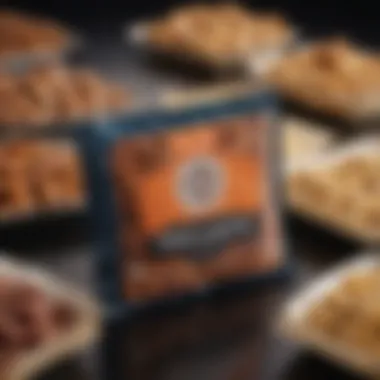MRE-Style Food: Culinary Innovation and Convenience


Intro
The world of food is ever-evolving, marked by innovations that aim to enhance convenience, flavor, and nutrition. Among these trends, MRE-style food stands out as a unique and practical offering. Originally designed for military use, these meals have found their place in various contexts, from outdoor adventures to daily convenience. Understanding the journey of MRE-style food can provide valuable insights into its significance in contemporary culinary practices.
By examining their origins, nutritional attributes, and recent advancements in packaging, we can appreciate how MREs have transitioned from emergency rations to a mainstream option that appeals to a diverse demographic. This exploration not only delves into the historical context of MREs but also highlights their role in modern dining experiences, catering to those who value efficiency without sacrificing quality.
Understanding MRE-Style Food
Understanding MRE-style food is essential for grasping the broader significance of culinary innovations in convenience. The evolution of this type of food not only highlights advancements in food technology but also reveals the changing perspectives on nutrition and convenience in modern life. As consumers seek out quality meals that are quick and easy to prepare, MRE-style food offers a viable solution. It provides nutritional benefits, catering to diverse dietary needs while also demonstrating how packaging technology can enhance meal accessibility.
Definition and Overview
MRE stands for "Meals Ready to Eat." This term refers to pre-packaged food meant for easy consumption without the need for cooking or elaborate preparation. Originally designed for military personnel, MREs have gained traction among outdoor enthusiasts and anyone requiring portable meals. These food packs are meticulously designed to have a long shelf life and are resistant to environmental factors. Often, they are accompanied by a flameless ration heater that allows the eater to warm the food without needing additional tools.
Historical Evolution of MREs
The history of MREs dates back to the 1960s when the United States military wanted a lightweight and durable solution for feeding troops in the field. The first MREs were not as palatable as modern offerings, consisting primarily of canned foods that lacked variety. However, through the decades, military rations underwent significant changes. By the 1980s, a comprehensive overhaul was underway, leading to improvements in flavors and textures.
Today, MREs have evolved into gourmet options, including dishes inspired by various global cuisines. This transformation shows not only the culinary advancements but also the military's acknowledgment of soldiers' dining experiences. As MREs became more palatable, they also found a place in civilian markets, especially for camping, hiking, and emergency preparedness.
The success of MREs today is a testament to human ingenuity in food technology and a reflection of contemporary dining demands.
Nutritional Considerations
Understanding the nutritional aspects of MRE-style food is vital. This type of food is designed to offer balance, satisfying both energy needs and dietary requirements of diverse consumers. Nutritional considerations cover caloric content, macronutrient balance, vitamins, and potential allergens. It's crucial for individuals utilizing MREs for different purposes, be it emergency preparedness, outdoor recreation, or convenience.
Caloric Content and Macronutrients
Caloric content serves as a foundation for understanding the energy provided by MREs. Typically, a standard MRE contains around 1,200 to 1,300 calories. This is essential for individuals engaging in physically demanding activities such as hiking or situations requiring endurance.
Macronutrients consist of carbohydrates, proteins, and fats. MREs usually include a mixture of these to maintain energy levels. On average, a well-balanced MRE provides:
- Carbohydrates: 50-60% for quick energy release.
- Proteins: 12-30% which aids in muscle repair and sustenance.
- Fats: 20-30% for longer-lasting energy.
Such a distribution supports essential bodily functions and provides adequate energy for both casual and intense activities.
Vitamins and Minerals in MREs
The inclusion of vitamins and minerals in MREs is significant for overall health. Vitamins like A, C, D, and B-complex are often added to ensure consumers receive essential nutrients that might be lacking in meals on-the-go. These contribute to immune support, skin health, and energy production.
Minerals such as iron, calcium, and magnesium are also carefully considered. Iron is critical for transporting oxygen in the body, especially during physical exertion. Calcium is essential for bone health, and magnesium aids muscle function. The reason these elements are pivotal in MREs is due to their roles in sustaining energy levels and overall health during physical and stressful conditions.
"Nutritional balance in MREs helps ensure individuals can perform effectively in various scenarios, from military to hiking adventures."
Dietary Restrictions and Allergens
As MREs evolve, addressing dietary restrictions and allergens has become a priority for manufacturers. Many people have allergies or specific dietary needs, such as gluten-free, nut-free, or vegan options.
- Gluten-free Options: Some MREs are designed to be gluten-free for those with celiac disease.
- Nut-free Packs: This avoids cross-contamination that can cause severe allergic reactions.
- Vegan Alternatives: Increasing awareness of plant-based diets has led to more MREs catering to vegan preferences.


By considering these factors, consumers who are health-conscious and have specific requirements can still rely on MREs without compromising their needs. MREs are becoming more inclusive in their offerings, making them suitable for a broader audience.
Packaging Technology Innovations
Packaging technology plays a crucial role in the appeal and practicality of MRE-style food. Innovations in this field enhance shelf life, convenience, and sustainability of meals that cater to diverse needs. Modern packaging not only preserves food quality but also meets the demands of mobility and emergency preparedness.
With the rise of outdoor activities and an increasing focus on disaster readiness, the design of packaging has become more sophisticated. Evolving technologies ensure that meals remain fresh and palatable, which is essential for consumer satisfaction. Furthermore, these advancements pave the way for improved environmental practices, aligning with growing consumer awareness regarding sustainability.
The importance of these innovations can be summarized as follows:
- Extended Shelf Life: Keeps food safe for longer durations, essential for MREs used in emergencies.
- Convenience: Easy-to-use packaging allows for quick meal preparation, suitable for outdoor activities.
- Sustainability: Enhanced materials reduce waste and improve recycling opportunities.
Vacuum Sealing Techniques
Vacuum sealing is a fundamental aspect of ensuring the freshness and longevity of MRE-style food. This method eliminates air within the packaging, significantly reducing oxidation that can spoil food. The effectiveness of vacuum sealing is evident in how it maintains taste, texture, and nutritional value over extended periods.
Additionally, vacuum-sealed packages are compact, making them easier to transport for activities like camping or hiking. This technique has grown beyond commercial applications; it is now accessible for home use. Consumers enjoy preparing meals in advance, then vacuum-sealing them for future convenience.
Temperature-Controlled Repackaging
Maintaining the right temperature is vital for preserving the quality of MRE-style food. Temperature-controlled repackaging ensures that meals are safe from bacteria and spoilage. By employing insulation materials and temperature-regulating technologies, manufacturers can efficiently protect food during travel and storage.
This technology is particularly important in contexts where meals may be exposed to varying environments, such as in emergency kits or during outdoor expeditions. Effective temperature control helps to guarantee that the MREs remain safe and tasty, improving overall user experience.
Sustainability in Packaging
Sustainability in packaging has gained significant traction among consumers and manufacturers alike. With a heightened awareness of environmental issues, there is a demand for materials that minimize ecological impact. Many companies now utilize biodegradable or recyclable packaging for their MRE-style food products.
This shift not only appeals to eco-conscious consumers but also reflects a broader trend in the food industry toward sustainable practices. Companies are exploring plant-based materials and reducing plastic usage, aiming to create products that are both practical and less harmful to the environment. The commitment to sustainability aligns with modern consumer expectations, enhancing the appeal of MRE-style food in today's market.
"Sustainable packaging is not just a trend; it is integral to the future of the food industry, influencing consumer choices and environmental impact."
By focusing on advancements in packaging technology, MRE-style food continues to evolve, catering to the needs of today's dynamic consumers. As these innovations unfold, they promise to reshape how we perceive convenience foods.
Culinary Innovations in MRE-Style Food
Culinary innovations in MRE-style food represent a notable shift from traditional perceptions of these meals. No longer confined to the realm of military rations, these innovations have made MREs more appealing to a wider audience. This democratization enhances convenience without sacrificing flavor or nutrition. As food lovers adapt to fast-paced lifestyles, MREs are evolving into more refined culinary experiences. Innovations embrace enhanced flavors, varied textures, and creative recipes that cater to diverse palates.
Gourmet MRE Options
Gourmet MRE options have emerged as a significant trend within the MRE market. These products typically feature higher-quality ingredients and a focus on taste that rivals traditional fine dining. Manufacturers are prioritizing culinary artistry in their recipes. For instance, brands like Meals Ready to Eat recently introduced gourmet varieties, offering options such as herb-infused chicken and quinoa salad.
The key benefits of gourmet MREs include:
- Diverse Flavors: An expanded range of seasonings and cooking styles.
- Quality Ingredients: Use of real vegetables, lean proteins, and whole grains.
- Appealing Presentation: Careful packaging emphasizes the meal’s gourmet nature.
Global Influences on MRE Recipes
Global culinary influences have reshaped MRE recipes, introducing international flavors that cater to an adventurous audience. For example, fusion cuisines blend traditional dishes from various cultures into MREs, such as Thai red curry or Indian masala. This diversity not only enhances palatability but also encourages consumers to explore flavors they might not encounter elsewhere.
Innovations come from understanding different tastes, leading to:


- Incorporation of spices: Authentic spices from each region make meals exciting.
- Cultural Awareness: MREs that pride on being reflective of global dining trends.
Customizable MRE Meals
Customizable MRE meals add another layer of engagement for consumers who prefer personalization. Some companies have started offering meal kits that allow customers to mix and match components to their liking, creating unique meals that suit individual preferences and dietary restrictions.
For instance, customers can select protein options, side dishes, and sauces to create a meal that is completely tailored to their taste. This consumer-centric approach fosters creativity and satisfaction, leading to a stronger affinity for the product.
Overall, the culinary innovations within MRE-style food have shifted from mere sustenance to a curated experience. They illustrate how the industry is learning from consumers and adapting to modern tastes, ultimately redefining convenience in the kitchen and outdoor experiences alike.
Modern Applications of MRE-Style Food
The relevance of MRE-style food extends beyond military operations and emergency contexts. Increasingly, these meals are being recognized for their advantages in recreational activities and everyday life. As people seek out convenient options to fit various lifestyles, the applications of MREs have evolved, meeting the demands of diverse consumer groups.
Recreational Use for Camping and Hiking
MREs have become essential for outdoor enthusiasts. When camping or hiking, their lightweight and easy-to-pack nature make them a preferred option. These meals typically have long shelf lives, allowing for easy storage without the need for refrigeration.
Additionally, preparing MREs is straightforward. Most come with simple instructions, making it easy to heat and eat without additional cooking gear. This is especially beneficial in remote locations. Popular choices often include pasta dishes, rice meals, or protein-packed options that require minimal cleanup.
MREs also provide balanced nutrition, which is vital for maintaining energy levels during strenuous activities. They can help avoid the fatigue that often comes with hiking or camping, making them a practical choice for those who value both convenience and sustenance.
Emergency Preparedness and Survival Situations
In times of crisis, having food that is ready to eat can be a significant advantage. MREs are a crucial component of emergency preparedness kits. They are designed to withstand harsh conditions and can remain edible long after being packaged.
When disasters strike, many people find themselves in survival situations. MREs play an important role in ensuring access to nutrition when fresh food may not be available. For families, keeping a supply of these meals can alleviate some stress during uncertain times. They offer a sense of security and readiness.
Important considerations in this context include:
- Shelf life: Most MREs can last five years or more if stored properly.
- Variety: Many brands offer diverse options, catering to different tastes and dietary needs.
- Ease of use: No need for cooking or extensive preparation simplifies meal distribution, especially during emergencies.
Trends in Urban Convenience Foods
The landscape of urban eating habits is shifting towards convenience food, and MREs are now surfacing as a notable category. In busy metropolitan areas, professionals often seek quick meal solutions, and MREs can fit seamlessly into this trend.
The appeal lies in how they combine simplicity with quality. Urban dwellers can enjoy gourmet-flavored options without the lengthy preparation typical of restaurant dining. Brands are innovating regularly to introduce meals that cater to modern palates, including vegetarian and gluten-free selections.
Furthermore, MRE-style food can be found at grocery outlets, food fairs, and even online platforms like reddit.com. This accessibility contributes to their growing popularity. Consumer awareness has surged, affecting perceptions positively, especially among younger, health-conscious demographics who appreciate convenience without compromising on taste.
"MREs reflect a convergence of necessity and culinary creativity, adapting traditional concepts to contemporary consumer lifestyles."
Consumer Acceptance and Trends
Understanding consumer acceptance and trends in MRE-style food is crucial for several reasons. First, it reveals how perceptions are shifting from niche military supplies to widely accepted meal options in various settings. This shift can be attributed to the increasing focus on convenience and the need for quick meal solutions in today’s fast-paced lifestyle. Moreover, these trends also highlight the importance of combining taste with practicality, catering to a wider demographic.
Demographics Embracing MREs
The demographics embracing MREs include outdoor enthusiasts, busy professionals, and families preparing for emergencies. Campers and hikers are often drawn to MREs due to their lightweight and easy-to-carry packaging. For busy professionals, MREs offer a ready-made meal solution that can save time without sacrificing nutrition. Families also recognize the value in having MREs as part of their emergency preparedness plans, providing comfort in knowing they are prepared for unpredictable situations.
Social Media Influence on MRE Popularity


Social media plays a significant role in shaping the popularity of MRE-style food. Platforms such as Instagram and TikTok are filled with visually engaging content, showcasing MRE unboxings and gourmet meal preparations. Influencers are highlighting the creativity behind these meals, sparking curiosity and interest. This visual representation, combined with simple recipes and tips for enhancing MREs, has turned what was once seen as solely a military product into a trendy, must-try culinary experience for a broader audience.
"As more people document and share their MRE meal experiences, the stigma attached to them diminishes, paving the way for more innovative approaches to these products."
Balancing Convenience and Quality
Achieving a balance between convenience and quality remains a critical concern among consumers. Many seek MREs that are not just easy to prepare but also satisfy their palate. Food enthusiasts want to experience flavors that rival those found in traditional meals. In response, manufacturers are innovating by using higher quality ingredients, enhancing flavor profiles while still maintaining the product's shelf stability. This balance resonates well with consumers who are increasingly conscious of their food choices, making them more likely to accept MREs as a viable meal option in their everyday lives.
Challenges and Critiques of MRE-Style Food
The exploration of MRE-style food would be incomplete without an examination of the challenges and critiques surrounding it. These elements are crucial as they reveal the complexities beyond convenience and innovation. Understanding the shortcomings of MREs enables consumers, manufacturers, and food enthusiasts to appreciate their benefits while recognizing areas for improvement.
Taste and Texture Considerations
Taste and texture are often the most prominent critiques of MRE-style foods. Many consumers associate MREs with bland flavors and an unappealing mouthfeel. While some modern MRE products aim to enhance flavors through gourmet ingredients and advanced cooking techniques, challenges remain. The long shelf life and production processes may affect the freshness and naturalness of ingredients. For example, the use of preservatives can lead to a compromise in flavor integrity.
Moreover, texture can greatly impact the eating experience. MREs, designed for durability and extended storage, often sacrifice texture for practicality. Foods may become overly chewy or exhibit an unsatisfactory consistency when reheated. Therefore, while some brands are committed to offering tastier options, the fundamental challenges surrounding taste and texture require continual innovation within this sector.
Health Concerns Over Frequent Consumption
Another significant criticism revolves around health concerns associated with frequent consumption of MRE-style foods. While they can provide adequate nutrition, many store-bought options contain high levels of sodium, sugars, and preservatives. Regular intake of such elements can lead to potential health issues, including hypertension and other lifestyle-related conditions.
This is particularly pressing for individuals relying on MREs in emergency situations or outdoor activities. They might consume these meals more frequently than populace typically does. Understanding the balance between convenience and health is crucial. Some manufacturers are beginning to recognize this gap and are creating healthier alternatives. These typically focus on organic or minimally processed ingredients while maintaining nutritional value.
The Perception of Processed Foods
The perception of processed foods is another notable challenge that MRE-style food faces. Many consumers are wary of processed meals, associating them with poor quality and unnatural ingredients. This stigma may lead to a hesitance to try or embrace MRE-style meals. Despite advancements in food technology, the perception remains entrenched in some circles.
As a result, educating consumers about the advancements in MRE production and showcasing high-quality ingredients is vital. It is also essential to differentiate between less desirable processed foods and those that utilize modern techniques to enhance flavor, nutrition, and sustainability.
Addressing the challenges associated with MRE-style foods cultivates an environment where innovation can thrive.
In summary, the critiques associated with MRE-style food are multi-faceted. Issues involving taste, health, and consumer perception highlight a complex relationship between convenience and quality. Future innovations must prioritize solutions to these hurdles to elevate the standing of MREs within acceptable food categories.
The Future of MRE-Style Food
The future of MRE-style food is an intriguing topic that reflects ongoing trends in convenience and culinary experiences. As consumer preferences shift, the food industry adapts to meet new demands. This section will explore key elements shaping the future of MREs, including innovations in ingredients and a strong emphasis on sustainability. Understanding these aspects is vital for anyone interested in the evolving landscape of food options.
Innovation in Ingredients and Meal Options
Innovation in ingredients is essential for the future success of MRE-style foods. Manufacturers are exploring the use of versatile and healthier components. These new ingredients often focus on nutritional density and taste improvement. Ingredients such as quinoa, legumes, and various plant-based proteins are becoming more common. These elements not only enhance the meal's overall flavor but also cater to growing dietary preferences.
Some manufacturers are also experimenting with flavors from around the world. By incorporating spices and techniques from different cuisines, MREs can become more appealing. This innovation allows for a richer culinary experience for consumers, who seek more than just simple meals.
"The introduction of gourmet options makes MREs more attractive to a broader audience."
This trend can lead to a wider acceptance among food lovers who had previously overlooked MREs. The emphasis on variety means consumers can choose meals that suit their tastes. Customizable options, where consumers can select proteins, grains, and flavors, will likely gain traction.
MREs in the Age of Sustainability
Sustainability has become a pressing concern across all industries, including food. The future of MRE-style meals must align with eco-friendly practices. This includes not only sourcing ingredients from sustainable suppliers but also adopting better packaging solutions.
Many consumers are now concerned about the environmental impact of their food choices. MRE manufacturers are taking note and shifting towards biodegradable and compostable packaging. This change reduces the carbon footprint and addresses consumer demands for responsible practices.
Moreover, the use of local ingredients can further enhance sustainability. When manufacturers source from nearby farms, it cuts transportation emissions. This trend ties in with the growing farm-to-table movement, where freshness and quality are prioritized.
As we look toward the future, MREs must adapt to these changing consumer mindsets. Innovation and sustainability are no longer optional; they are essential for success in a competitive market.







